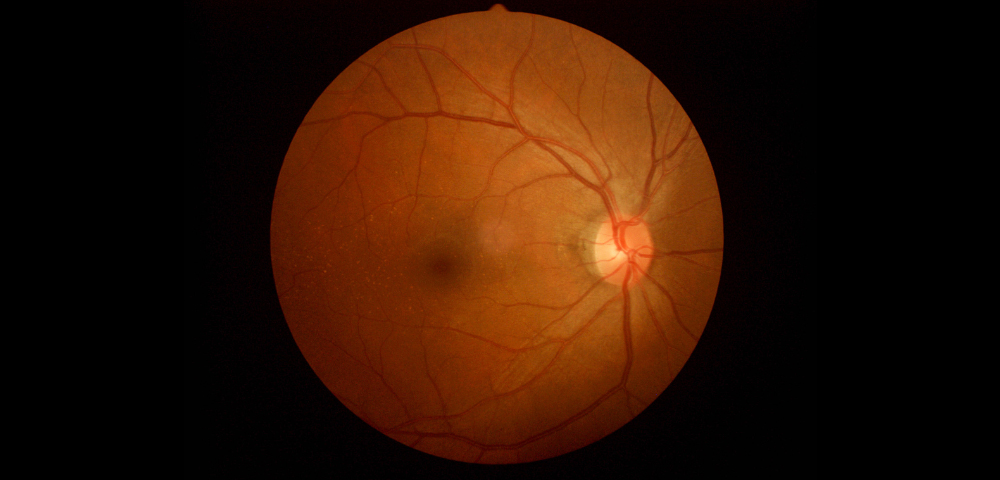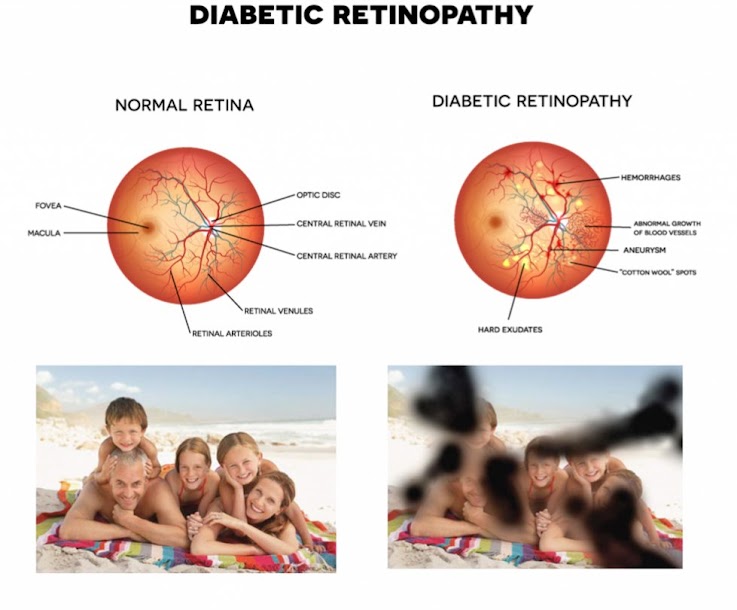Diabetic Eye Care in Navi Mumbai
At Laxmi Eye Institute, Internationally recognized eye hospital in Navi Mumbai, centres at Panvel, Kharghar, Kamothe and Dombivali.

Diabetic Retinopathy in Navi Mumbai
Diabetes affects the blood vessels of the entire body, but the damage is mostly seen in the blood vessels of the eye (retina), kidneys, heart, and brain.
Diabetic retinopathy is a condition in which blood vessel damage leads to their blockage, bleeding, leakage of blood proteins and water, and formation of new blood vessels.
Diabetic Retinopathy (DR) is an important cause of permanent vision loss, and can even lead to blindness.
Who is at risk of developing diabetic retinopathy?
Patients who are diabetics with fluctuating blood sugar levels, long-term diabetes, and diabetic who also have high blood pressure (hypertension), high cholesterol, kidney disease (nephropathy), and who smoke, are at a higher risk of developing retinopathy.
Can diabetic retinopathy be prevented?
Yes, it can be prevented by keeping the blood sugar levels under tight control. Adequate control of other parameters like blood pressure, cholesterol levels, nephropathy is also essential to prevent and or delay the progression of diabetic retinopathy.
What are the signs and symptoms of Diabetic Retinopathy?

In the early stages, diabetic retinopathy may not have any symptoms at all and serious retinal changes may co-exist with normal vision.
In advanced stages, the patient may experience:
A sudden drop in vision, due to internal bleeding or retinal detachment
A gradual decrease in vision or blurring, due to retinal swelling (edema)
‘Floaters’ or black or red-coloured spots, due to internal bleeding
What are the types of Diabetic Retinopathy?
DR proceeds through various stages. In the early stages of the disease, the patient most often does not have any vision-related complaints. If such a stage is reached, treatment can be initiated to preserve vision for the rest of one's life.
Two main retinal problems are seen in DR
New blood vessel formation (Proliferative Diabetic Retinopathy, PDR) – which can lead to internal bleeding and retinal detachment
Leakage in the central retina (Macular Edema) – which causes retinal swelling and drop in vision
Both of these problems need to be tackled simultaneously.
Consult a Retina Surgeon in Navi Mumbai at Laxmi Eye Institute.
How do we diagnose Diabetic Retinopathy?
The best method is by dilated fundus examination by a qualified retina specialist. Eye drops are used to dilate the pupils of the eyes, which allow the retina to be seen in full detail.
Your retina specialist may advise certain tests:
Fundus Photography: This test serves as a record of the present status, which is useful for comparing any changes that may occur with time.
OCT (Retinal scanning): This test can confirm retinal swelling (macular edema) and also measure the actual retinal thickness
FFA (Angiography): In this test, a dye is injected in the hand veins and photographs of the retina are taken. Specific areas of leakage, abnormal blood vessels, and blockages can be visualized.
What are the treatment options for diabetic retinopathy?
Prevention is better than cure. By keeping one's diabetes under control, sight-threatening problems can be prevented. Damage that has already occurred cannot be reversed, but further damage can be delayed or averted.
Retinal Laser can be used to close the new blood vessels that develop in PDR. Once these blood vessels close, the risk of future bleeding or retinal detachment is minimized
Eye injections (Accentrix™ or Lucentis™, Avastin™, Ozurdex™, triamcinolone) are helpful in reducing retinal swelling and improving vision.
Vitrectomy surgery may be required to remove blood within the eye that does not dissolve on its own or to restore the retina to its normal position.
All these treatments are available at Laxmi Eye Institute and are administered by our highly qualified retina specialists in Navi Mumbai. This is one of the only centres in the region equipped with the latest Multi-spot Retinal Laser by Carl Zeiss, Germany.
Protect Your Eyes from losing vision due to Diabetic Retinopathy.
You can protect your eyes from losing vision. Meet our retina specialist every year for a retina check-up. Early diagnosis and treatment can preserve vision for the rest of your life.
Age-related Macular Degeneration-
As the name suggests, this is a disease that occurs due to ageing. It is seen in people above the age of 50 years. In this disease, it is the 'macula', the central area of the retina, that gets damaged. AMD Stand for Age-Related Macular Degeneration.
AMD is one of the leading causes of irreversible low vision in the world. It is very common in the western world, principally because of a longer lifespan, but is now being recognized more and more in India.
Who Is At Risk Of Developing Age-related Macular Degeneration?
This disease can occur in anybody after the age of 50 years. Studies have shown a few other risk factors:
Hypertension
Smoking
Family history
Specific genetic mutations
What Are The Signs And Symptoms Of Age-related Macular Degeneration?
The earliest and sometimes only symptom is a painless loss of vision. The patient may experience difficulty in reading, or looking at far-off objects clearly, or recognizing people's faces. Sometimes this may be noticed suddenly by the patient when they close one eye, as the disease can occasionally affect one eye more than the other.
Another important symptom is the 'waviness' of objects that should be straight. This distortion is called metamorphopsia.
AMD affects only the central vision. Patients may notice a central black spot wherever they try to focus, but it never causes total blindness.
What are the types of AMD?
In general, there are two types of AMD – Dry and Wet.
Dry AMD is significantly more common than the wet form. However, it can slowly progress to the wet stage. This stage is characterized by slowly progressive damage to the photoreceptor and retinal pigment epithelial cells.
Wet AMD is less common, but 90 per cent of patients with vision loss due to AMD have this type of disease. In this stage, new blood vessels begin to develop underneath the retina ('neovascularization'), which leads to bleeding and leakage of water into and below the retina.
How do we diagnose AMD?
The best method is dilated fundus examination by a qualified retina specialist. Eye drops are used to dilate the pupils of the eyes, which allow the retina to be seen in full detail.
Your retina specialist may then advise certain tests:
Fundus Photography: This test serves as a record of the present status, which is useful for comparing any changes that may occur with time.
Fundus Auto-fluorescence: A special type of photograph, it can clearly delineate the extent of damage in patients with dry AMD.
OCT (Retinal scanning): This test can detect retinal swelling (macular edema) and also measure the actual retinal thickness for future reference.
FFA (Angiography): In this test, a dye is injected in the hand veins and photographs of the retina are taken. Specific areas of leakage, abnormal blood vessels, and blockages can be visualized.
What are the treatment options available at Laxmi Eye for Age-Related Macular Degeneration?
This disease cannot be entirely cured or reversed.
In the dry stage, treatment is aimed at stabilizing or slowing the speed at which worsening occurs. This is the rationale behind prescribing antioxidant and vitamin supplements.
In the wet stage, treatment tries to halt further damage, and in early cases vision can improve significantly. The medication required is administered directly into the eye in the form of injections. A number of drugs are available – namely Avastin™, Accentrix™ (formerly called Lucentis™), and Eylea™. All of these are regularly administered at Laxmi Eye Institute.
Occasionally, a highly specialized type of 'cold' laser called PDT (photodynamic therapy) is useful. In this procedure, a dye Verteporfin™ is injected in the arm, and laser light is applied to the abnormal retina blood vessels.
Consult Retina Specialist in Navi Mumbai at Laxmi
Remember, early treatment can help to stabilize vision and can even improve vision. A specialist retina surgeon should operate as it is a very delicate structure.
Make An Appointment
All Copyright© Reserved @ Laxmi Eye Hospital And Institute
